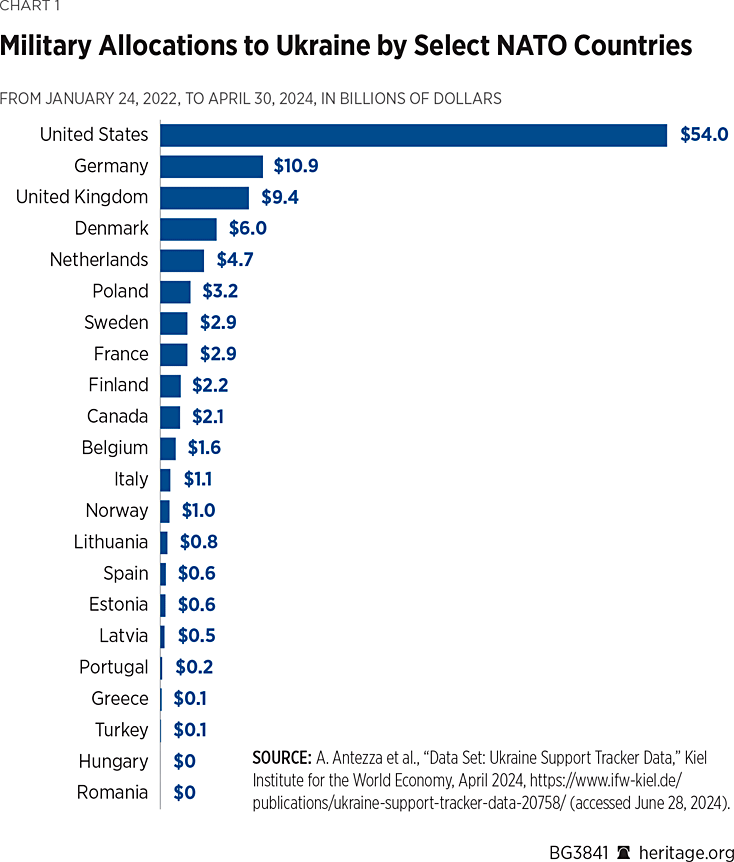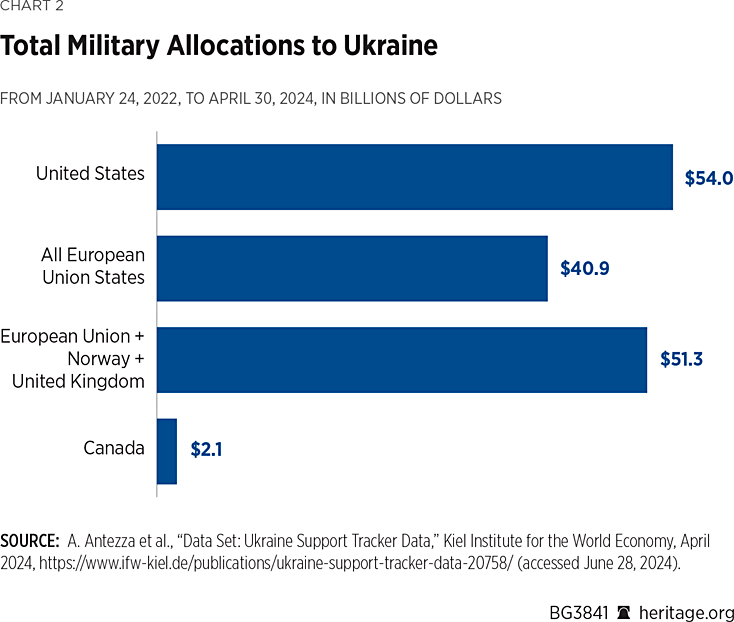The United States is beset by crises around the globe, with active conflicts in both Europe and the Middle East, and a potential conflict in Asia that would be catastrophic for American security and the economy. The American military’s readiness to fight has atrophied, with munitions shortages, recruiting problems, and endless shipbuilding delays and cost overruns.
Adjusted for inflation, the U.S. has been spending less on its military since the 1990s than it did during the Cold War, and the budgets for most of its North Atlantic Treaty Organization (NATO) allies dropped even further. In the 1950s, the U.S. spent up to 10 percent of gross domestic product (GDP) on defense; in the 1980s, it spent up to 6 percent. But since the end of the Cold War, defense spending has usually been only around 3 percent of GDP, even as the U.S. has expanded commitments around the globe and fought wars in Afghanistan, Iraq, Libya, and elsewhere.
At the same time, Chinese economic and military might have expanded drastically. China’s economy is now roughly 70 percent that of the United States, and it thus represents a peer challenge even greater than that posed by the Soviet Union during the Cold War.REF Meanwhile, Russia’s economy is smaller than France’s alone and dwarfed by Europe as a whole.
Americans now find themselves in a world of difficult choices and potential threats, in a way that has not been true in a long time. If American policymakers attempt to do everything everywhere, and allocate scarce military resources to secondary or even tertiary security challenges, they will be unable to deter primary ones.
One of America’s greatest advantages over China and Russia is that America has a network of wealthy and capable allies who also have an interest in maintaining the current international system and preventing spoiler powers from overturning it. Many of America’s allies have stepped up in a big way over the past several years, providing significant aid for Ukraine and investing in their own military budgets. Yet, some of the wealthiest countries in Europe have not significantly increased military spending, preferring instead to spend money on lavish social programs and climate change initiatives. Some countries have been content to watch America and others lead the effort in Ukraine as they sit on the sidelines.
This needs to change. All Europeans need to take primary responsibility for European security so that America can focus on the far bigger challenge posed by China in the Indo–Pacific. The European countries that have been doing the right thing by investing in their defense should be directing criticism at the European countries that have not been doing so, not at the United States, which continues to be the primary provider of security in Europe.
Military Aid to Ukraine
Supporters of increased U.S. military aid to Ukraine rely on a number of faulty arguments to make their case. They argue that:
- Europe has stepped up in a big way to support Ukraine;
- Military donations to Ukraine deter China from attacking Taiwan;
- There are no trade-offs between aid to Ukraine and aid to Taiwan; and
- The United States currently has the capability to take the lead in Ukraine and to deter or defeat the Chinese in the Western Pacific (not to mention Houthis in Yemen and the Iranian regime).
These are all faulty arguments. In fact:
- Some European nations have stepped up, while others have not, and America is by far the largest contributor of military aid to Ukraine. If some countries in Europe are contributing and others are not, the U.S. should neither praise nor condemn Europe as a whole.
- The argument that aid to Ukraine deters the Chinese in the Western Pacific is based on guesswork and dubious assumptions. In reality, deterrence is based on in-theater assets that provide combat power, not on the U.S. perception of how the Chinese measure U.S. resolve in a different theater. That is, China will be deterred if it believes it cannot win, and it will believe it cannot win if it sees a U.S. military capable of defeating it, as well as well-armed Taiwanese and Japanese militaries.
- There are clear trade-offs between aid to Ukraine and aid to Taiwan. For example, Patriot missiles and other air defense assets currently being sent to Ukraine are also needed in Taiwan.
- U.S. military spending is far lower than it was during the Cold War, and the Chinese Communist Party is a bigger threat than the Soviet Union ever was. The American military is not invincible, and American policymakers must prioritize primary security concerns over secondary ones.
Argument: Europe Has Stepped Up to Support Ukraine
Response: This argument is only half true. Certain European countries have indeed punched way above their weight and contributed very substantial amounts of military aid to Ukraine.REF Poland, Estonia, Latvia, Lithuania, Finland, Sweden, Denmark, Norway, the Netherlands, Britain, and Germany deserve praise for having taken initiative on what is primarily a European security matter.REF
France, Greece, Italy, Portugal, Romania, Spain, Turkey, and some others have not contributed enough military aid to Ukraine and should not be included in the comment “Europe is stepping up.” (Turkey is included because sometimes this is phrased as “NATO is stepping up.”)REF The U.S. should not praise or condemn Europe as a whole, because not every European country’s contributions are the same.


France has received praise from many Ukraine hawks recently, primarily because of President Emmanuel Macron’s bellicose statements about sending troops to Ukraine. But, France’s miliary aid numbers show that it has not taken the lead on support for Ukraine in any meaningful way. France’s allocations are only around $2.9 billion in military aid to Ukraine, while Germany is at roughly $10.9 billion. The United States has already allocated $54 billion in direct military aid to Ukraine. Macron talks big about Europeans having primary responsibility for their own defense (a stance the U.S. should welcome) but has failed to match action with rhetoric in France’s support for Ukraine, instead allowing the United States and Germany to do the heavy lifting.REF
Italy and Spain, respectively the fourth and fifth biggest economies in Europe, have been especially lackluster in their military support to Ukraine and do not deserve to be included in general praise for European support. Italian military aid stands at about $1.1 billion in military aid to Ukraine and Spain’s is a paltry $600 million. Spain has therefore given less than far smaller Lithuania, which has allocated $760 million. Spain has recently pledged to increase aid by $1.1 billion, although this would still be far less than smaller economies like Denmark.REF
In terms of punching well above their weight in military aid donations, Denmark, Sweden, Finland, the Baltic states, and Poland deserve exceptional praise. Denmark alone has allocated $6 billion in military aid to Ukraine.REF
Germany’s case deserves special consideration, because it has both the largest economy and population in Europe and is therefore the linchpin for any successful effort by Europeans to take primary responsibility for their own security. Germany has received much criticism from Americans over the past two decades for having allowed its military spending to atrophy and its military capabilities to decline substantially as a result. This criticism was more than warranted. Some argue that German reticence on military spending is a legacy of its post–World War I transformation, but this argument does not hold up to scrutiny. During the Cold War, Germany had a large and capable military and was a core contributor of defense capabilities to NATO.
Germany has made considerable progress in rectifying this shortcoming over the past two years, not least in its military contributions to Ukraine. Germany is by far the second-biggest contributor of military aid to Ukraine after the United States, having given roughly $10.9 billion.REF At the same time, Germany has committed to keeping its defense spending above 2 percent of GDP from now on.REF Germany has a long way to go in fixing its insufficient military spending since the end of the Cold War, and U.S. policymakers should continue to push Germany to do more, not least because Germany’s economic heft means that sustained increases in German defense spending would result in a Europe capable of being primarily responsible for its own defense. For now, though, Germany deserves praise for having contributed so substantially to aiding Ukraine and for having made significant increases in its own defense spending since 2022.
The European Union absolutely has more funds available to prioritize aid to Ukraine and increased defense spending among its members if it so chooses. From 2021 to 2027, the EU has announced that it will be spending 580 billion euros (roughly $625 billion) on climate change initiatives, aiming to allocate at least 30 percent of its budget to address climate change.REF EU leadership does not seem to consider Russia to be as existential a threat to Europe as climate change.
As of April 30, 2024, the United States had allocated $54 billion in military aid to Ukraine.
Argument: Military Donations to Ukraine Are a Deterrent to China in Taiwan
Response: When the U.S. withdrew troops from Vietnam, it did not embolden the Soviets in Europe. The Soviets did not see the U.S. military leave South Vietnam and the North Vietnamese overrun Saigon and think: “U.S. resolve is low, now is our chance to attack West Germany.” The reason they did not think this is that the U.S. maintained a massive military presence in West Germany, alongside large and capable Western European militaries. The Soviets were deterred by U.S. capacity and capability in Europe, not by their evaluation of U.S. resolve in conflicts on the other side of the globe.REF
Likewise, it is impossible to say whether the Chinese are encouraged or deterred by U.S. actions in Ukraine. It is more likely that Chinese decision-making is primarily influenced by China’s assessment of whether it can achieve its military goals. If China’s military goal is to seize Taiwan, its strategists are assessing whether this is possible, given the size and capabilities of the Taiwanese military first, and the American and Japanese militaries second.
Argument: Aid to Ukraine and Aid to Taiwan Requires No Trade-Offs
Response: There are trade-offs between what Taiwan and Ukraine need, and U.S. weapons inventories are insufficient to meet both parties’ requirements.REF
The following are examples of weapons systems that the U.S. has given to Ukraine that Taiwan could also use to defeat a Chinese invasion force:
- High Mobility Artillery Rocket Systems (HIMARS),
- Army Tactical Missile System (ATACMS),
- Guided Multiple Launch Rocket System (GMLRS),
- National Advanced Surface-to-Air Missile System (NASAMS),
- Patriot Air Defense System,
- Harpoon anti-ship missiles,
- Stinger man-portable air defense systems,
- Javelin anti-armor systems, and
- Tactical unmanned aerial vehicles (UAVs).REF
Argument: The U.S. Has the Capacity to Defeat Russia, While Deterring and Potentially Defeating China, the Houthis, and Iran
Response: This view is often summed up with the phrase “the United States can walk and chew gum at the same time.”REF Proponents of aid to Ukraine argue that the U.S. can counter Russia in Ukraine to the tune of $174 billion (with more planned) and at the same time build a military infrastructure in the Western Pacific capable of deterring China and defeating it, if necessary. Proponents also tend to argue in favor of the United States expending its already low stores of precision-guided munitions by bombing Houthis in Yemen and being ready to confront Iran, if necessary.
To the contrary, it is not a given that the United States could currently prevent China from seizing Taiwan, and even if the United States were to win a war with China, the cost in American lives would be exceptional. A Center for Strategic and International Studies wargame had the United States winning in most scenarios, but at the cost of “dozens of ships, hundreds of aircraft, and tens of thousands of servicemembers,” calling for the United States to “strengthen deterrence immediately.”REF
China has been involved in a massive military build-up over the past several decades, and by some counts has a military budget of roughly $700 billion—approaching that of the United States.REF By all counts, the Chinese defense budget increases substantially every year and China has prioritized the procurement of ships, planes, and munitions it would need for an attack on Taiwan.REF
Those who argue that the United States can “walk and chew gum at the same time” are refusing to look reality in the face, ignoring the economic rise of China and accompanying military build-up, and pretending that the United States is still in the unipolar moment it enjoyed in the 1990s. America still has the best military in the world, but it is not invincible, it has been declining, and it is not capable of doing everything, everywhere, all at once. American policymakers cannot wage wars of choice or wars of secondary concern without consequence and must instead prioritize the security issues that matter most for the American people.
Conclusion
The United States faces a multi-polar world with bad actors and threats in disparate theaters around the globe. As a percentage of GDP, the United States spends far less on its military than it did throughout the Cold War, yet the military is being asked to do just as much or more as it did then. Since the 1990s, American policymakers have not carefully husbanded the nation’s resources and aligned U.S. military missions and spending with strategy—and have instead wasted them on wars of choice. The maximalist approach to foreign policy, in which the United States does everything, everywhere, all at once, would require a truly massive increase in defense spending that does not seem politically feasible in the near term. Europeans must take primary responsibility both for Ukraine and for their own security, as the United States, by necessity, shifts resources and assets to the Indo–Pacific.
Wilson Beaver is Policy Advisor for Defense Budgeting in the Douglas and Sarah Allison Center for National Security at The Heritage Foundation.



